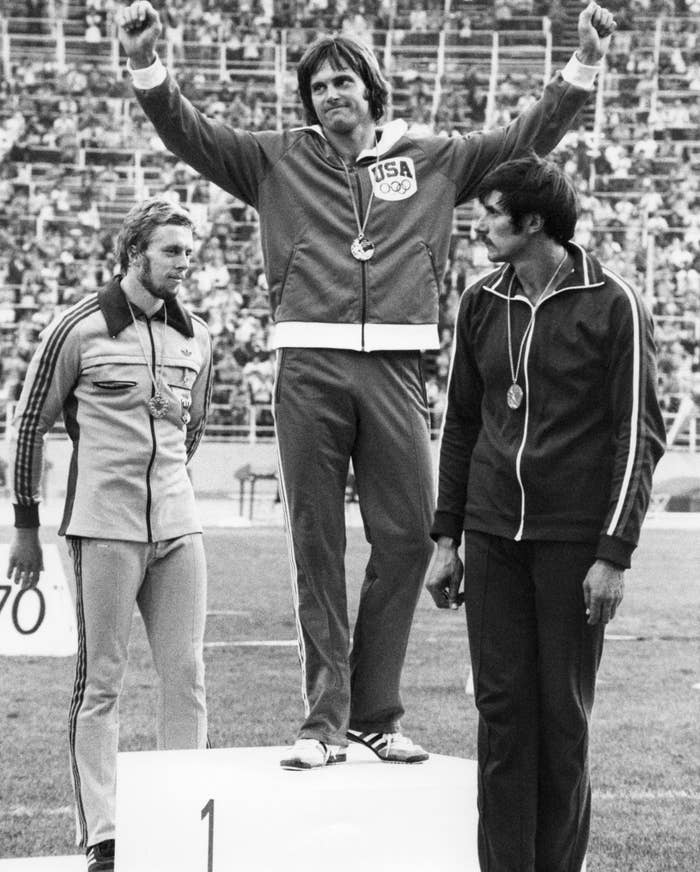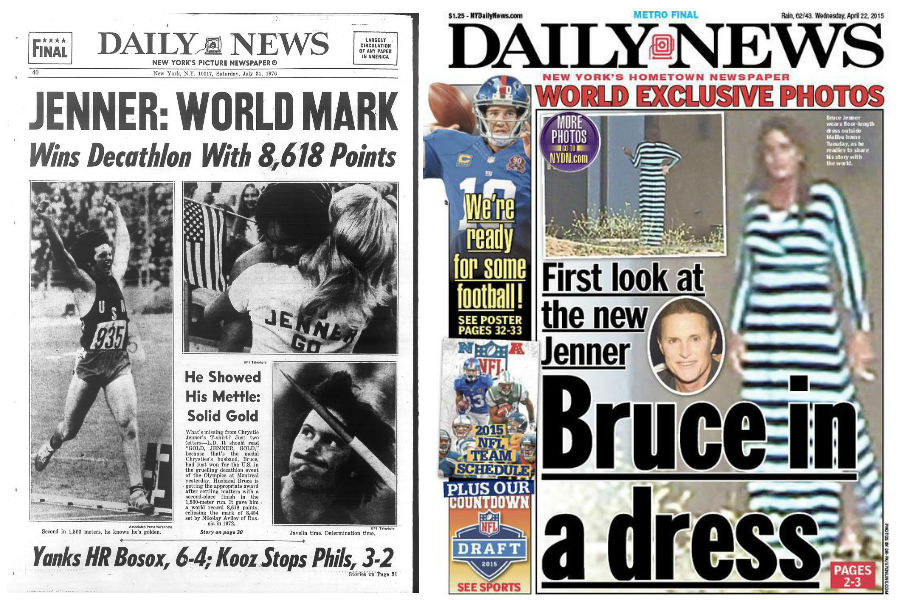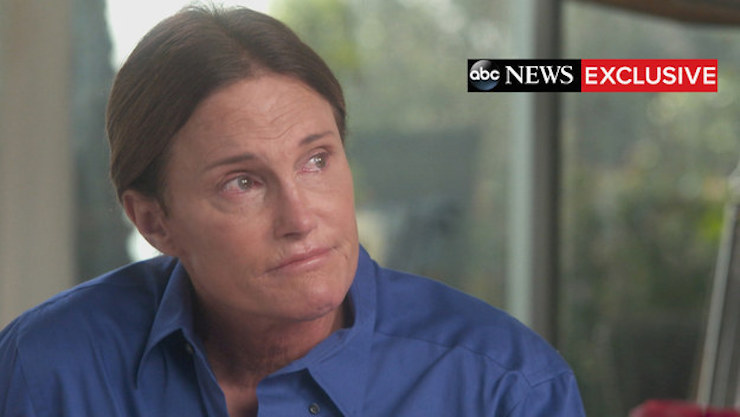
Growing up, I thought of Bruce Jenner as the kind of man I could never become. Now, I think of her as the kind of woman I try to be.
As an '80s kid who lived close to an American army base in the U.S.-backed Philippines, I watched recycled footage of Jenner’s athletic accomplishments for years. I was this provincial Filipino boy, and she was one of the most admired and popular men in the world. It seemed like we had nothing at all in common — but the two of us shared the same secret desire to be women someday.
Jenner, at one point, held the title of “world’s greatest athlete,” after winning the Olympic decathlon at the 1976 Montreal Games. It was the height of the Cold War, and Jenner displaced her Soviet rival Mykola Avilov, gaining iconic status in the year of the American bicentennial. Her body became a symbol of a particular type of American dominance that stood in stark contrast with the brusque, unsmiling faces of her Eastern bloc rivals. She was powerful yet gentle, exceedingly handsome yet affable — the very image of what America wanted to project to the world. In my childhood fantasies, she was the man that I could never be; the man I wanted to be with; the handsome and powerful symbol of the country that saved the Philippines from Japan during World War II.

Regardless of how one knows Jenner — whether from her days as an Olympic decathlon champion or her recent reality TV fame as part of the Kardashian family — last night’s interview with Diane Sawyer overturned many assumptions about her. As well as openly identifying as transgender for the first time, Jenner also movingly revealed that her life has been defined by running away from a womanhood that she has only recently found the courage to fully embrace, with the love and support of the rest of her family. Before the interview, I sat in front of my TV scared about how Jenner and Sawyer would represent trans people like me.
Perhaps there hasn’t been a coming out this monumental since 1985, when Rock Hudson, one of the iconic male movie stars of the 1950s, announced he had AIDS, and essentially outed himself as gay. That, too, confronted the public assumption of what it meant to be an iconic American man, and showed how a virile body could harbor a secret that was associated with deviance and illness. Despite the devastating effects of the AIDS crisis, it forced homosexuality to become visible, and catalyzed the political awakening of the LGBT movement. Hudson’s illness, and eventual death, gave that movement a widely known face.
There are important differences between Hudson and Jenner. While Hudson was forced out of the closet by disease, transgenderism is inherently more visible than homosexuality in most cases — gender expression pervades almost every aspect of daily life, while sexuality can be limited to the private sphere. That is why trans people are generally more vulnerable to harassment and violence. While Hudson was able to carry on relationships with other men for decades, the steps Jenner has taken to permanently transition to a new gender cannot be so easily hidden (even though she did manage to take hormones and risk leaving the house in women’s clothes in the '80s).
Jenner does not have the choice to transition quietly, to move to a city where few people recognize her. Yet as difficult as this likely is for her, the necessary visibility of Jenner’s life forces the public to confront the reality of her transition, particularly because of her previous role as one of the icons of American masculinity.

The American media in 1976 were infatuated with Jenner, as much for her looks as for her athletic prowess. Time magazine called her “beautifully sculpted” and described “the waning light shining on his flapping chestnut hair” as she crossed the finish line. “We have a man who not only can perform an extraordinary athletic feat but is also movie-star handsome and has game-show effervescence,” crooned the New York Times. “His wife is just as pretty as he is, and they probably will go on to fame and fortune.” The way many outlets wrote about Jenner’s appearance bears distinct hints of the feminine. Back then, Jenner was allowed to be pretty as long as she conformed to masculine standards. Sculpting a beautiful body by means of intense athletic training was received by the public far differently than the eventual sculpture of her body through surgery, which opened her up for immense derision.
“Me of all people, Bruce Jenner, has to deal with these issues,” she told Sawyer as their interview began, the timbre of her voice soft while she wiped tears from her eyes. Jenner seemed aware that those who knew her as the hypermasculine athlete may find it particularly bizarre that she wants to live as a woman. She explained that her obsession to be the world’s greatest athlete was driven by her desire to reject a socially unacceptable womanhood. “I was running away from myself,” she said. “Running away from who I was.”
So the most lauded American athletic feat during the Cold War — a feat that became a symbol of American dominance and power — was driven not by desire to embody the highest achievement of masculinity, but by Jenner’s socially unacceptable desire to be female. Jenner has rewritten not just her personal history but also the history of American sports and her body’s place within it. As her former Soviet rival, Avilov, joked in a message he sent to Sawyer, “How could I have lost to a woman?”
It also seems as though she wants to rehabilitate reality TV for the purposes of gaining support for transgender people. When Sawyer asked her about her role in Keeping Up With the Kardashians, she said, “The one thing that could really make a difference in people’s lives, I couldn’t tell anyone.” Her words imply a future where her plans to document her transition can serve the important purpose of educating the public about trans issues.

If this interview is any indication, then there’s some promise that Jenner’s future reality show could open some minds and hearts, as it was full of poignant moments of support from her family. The ones that stood out for me include her story about Kanye West encouraging Kim Kardashian to accept Jenner for who she is by saying, “I can’t be nothing if I can’t be me, if I can’t be true to myself.” Another powerful moment involved Jenner’s mother, Esther. “I was so proud of you when you won the Olympics in Montreal,” she said. “I never thought I could be more proud of you, but I’m learning I can be.” The support of Jenner’s family can serve as a model of how to handle a loved one’s gender transition, and educate the public about why such a change is often necessary despite the difficulties of adjustment.
But prejudices can take a long time to eradicate — even, sometimes, from trans people ourselves. Ever since Jenner has been the topic of conversation, I’ve been forced to confront my own internal transphobia. Over the years, a number of people have expressed to me how they understand why I transitioned because I’m “naturally” feminine and therefore passable, but couldn’t understand why conventionally attractive and powerful men who have trouble passing as women would ever want to transition. Part of me felt superior to those who didn’t pass.
When Jenner came along, I was forced to confront my own prejudice as jokes about her transition filtered through my social media feed, and a prejudice I ignored became one I needed to confront, as it became clear to me once and for all that a trans woman’s appearance shouldn’t determine whether or not she should be treated with respect. Being transgender is not a choice, whether or not a person happens to conform to conventional norms in their true gender, and that it’s even more important to respect trans people who have previously led established male lives. It’s distinctly possible that I wouldn’t have had the guts to transition had my body been more masculine, so it’s the fortitude of women like Jenner that deserves immense praise — especially because trans women who find it hard to pass are a rarity in mainstream American media.
For many months, those same mainstream media have frequently exploited the spectacle of Jenner’s female unacceptability. Various outlets have reveled in documenting what they perceive to be her feminine failures in using surgery to sculpt a new type of appearance. She was the butt of transphobic late-night jokes; in the most cruel, Jimmy Kimmel Live screened a fake Facebook Look Back video that interspersed pictures of Jenner over the years with slides like, “You joined in 2004, back when you were a man,” and, “Now you’re our weird Aunt Bess.” This was in February 2014, before Jenner hinted at any transition plans.
Even presumed allies like Jill Soloway, the Golden Globe-winning director of the much-revered Amazon series Transparent, about the struggles of an older transitioning trans woman and her family, posted a photoshopped picture on Facebook that parodied Jenner by replacing pictures of the Transparent cast with a feminine-looking Jenner and the Kardashians, under the title Transdashian. With this moment, Soloway demonstrated how even well-meaning people can’t help but make a joke out of a person struggling with gender transition.

Three days before Jenner’s interview with Sawyer, the cover of the New York Daily News featured illegally obtained photographs of Jenner in feminine attire, with the enormous headline “Bruce in a Dress,” emphasizing Jenner’s male name attached to an item of clothing most closely identified with being a woman. The first line of the accompanying article, “Who’s that lady?”, is a taunt I’ve specifically heard bigots on the street use when they’ve encountered trans women who don’t pass. Jenner’s dour expression in these pictures stand in stark contrast with her triumph in 1976, also immortalized in the Daily News, when she was cheered on by thousands of people and embraced by a loving wife. Everything about the 1976 cover says success, while the 2015 cover only communicates disappointment.
These were just a few of the numerous transphobic jokes and depictions that preceded Jenner’s announcement. Even if her interview with Sawyer was done partly for publicity, it was also an opportunity for Jenner to control her narrative — to counter an image of her as deviant in favor of her simple desire to live as a woman. When Sawyer asked what Jenner wishes for, Jenner said, “I wish to be able to have my nail polish for long enough that it can chip off.” Jenner was effectively asking the American media — and, by extension, the American public — why they are so enamored with gender roles that someone can’t perform the inoffensive action of going out with painted nails just because she happens to have been assigned male at birth. When she implored the public, “Have an open mind and an open heart. I’m not a bad person. I’m just doing what I have to do,” I asked myself why she needs to feel responsible to us for choosing to live as herself, why we have the right to think ill of her just because she dares to embody her own personal truth.
Yet even as I fully support Jenner’s transition, I still struggle to let go of the man in my head from all those years of watching her on TV. There’s something pathetic about how hard it is for me, a trans woman, to displace the iconic image of Jenner’s ideal male body with the reality of her womanhood. I can only imagine what it’s like for cisgender people who once lived vicariously through Jenner’s athletic achievements and rapturous good looks when she presented as a man. It’s likely that no other trans woman has borne the weight of this much collective expectation.
Jenner has and will make choices I don’t agree with, yet I still can’t help but admire her. That her transition will be the subject of a reality TV show concerns me given how limited that genre can be in portraying the actual nuances of reality. I wonder about how attached she seems to be to conventional constructions of beauty — so much that she doesn’t seem ready to be fully herself until she is “transformed.” Few people can afford the type of transformation she envisions, and many want to live publicly as women without access to surgery, fabulous outfits, or a “glam room,” as Jenner described her future closet. As much as Jenner risks turning her life — and, by extension, the lives of all trans women — into a distorted spectacle, the reactions she is sure to arouse will also be an opportunity for the American public to grapple with their own distorted perceptions. As has been the case throughout her career, Jenner’s public life will be less about her as an individual and more about what she and her body represents. In 2015, like in 1976, the public’s relationship with Jenner’s body will reflect American values, and it’s up to each of us to determine whether those values will include a fundamental respect for all transgender people.
[Author’s note: While the Gay and Lesbian Alliance Against Defamation (GLAAD) recommends that the media use male pronouns when referring to Jenner, stating that “at this time, Bruce Jenner has not indicated that a new name or pronoun should be used,” I disagree. Since Jenner told the public that she has never fully thought of herself as male, I don’t believe that we should necessarily defer to using male pronouns just because that’s how Jenner has been referred to in the past.]
